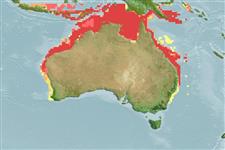Natator depressa (Garman, 1880)
Flatback turtle| Native range | All suitable habitat | Point map | Year 2050 |

|
| This map was computer-generated and has not yet been reviewed. |
| Natator depressa AquaMaps Data sources: GBIF OBIS |
Classification / Names Common names | Synonyms | CoL | ITIS | WoRMS
Not assigned | Testudines | Cheloniidae
Environment: milieu / climate zone / depth range / distribution range Ecology
Benthopelagic; depth range 0 - 200 m (Ref. 1397). Tropical; 6°S - 38°S, 109°E - 157°E (Ref. 1397)
Distribution Countries | FAO areas | Ecosystems | Occurrences | Introductions
Indo-West Pacific: endemic to Australia.
Length at first maturity / Size / Weight / Age
Maturity: Lm ? range ? - ? cm Max length : 96.0 cm CL male/unsexed; (Ref. 1397); max. published weight: 84.0 kg (Ref. 1397)
Short description Morphology
Adult: body flat, and carapace smooth, nearly elliptical with upturned margins. In subadults: carapace rim indented from middle to the back. Head: medium-sized, subtriangular, flat on top. Snout: longer and nearly equal to orbit. Scutes: ventrally consists of 6 pairs of main scutes, one intergular scute, a pair of postanal scutes and 4 poreless inframarginal scutes
in each bridge with only one axillary scale in each bridge. Single visible claw in each flipper. Color: adults dorsally dull olive-grey with pale brownish yellow
tones marginally; neck and head pale tone. Plastron ventrally are creamy white. Young individuals: brightly colored. Hatchlings: carapace scutes form a dark grey reticulate pattern; each scute are pale olive green; carapace rim and flippers are cream-colored band. Ventrally cream-white, except central part of each flipper which is bluish-grey diffuse spot.
This species inhabits the shallow waters especially on coral reef areas like Great Barrier Reef and continental islands. Nesting only takes place in Australia. The peak season varies in localities: in southeast Queensland, November to January; in northern beaches, occurs throughout the year with a peak between March and April. Renesting interval usually lasts from 12 to 23 days. The nesting cycle at Mon Repos, ranges from 1 to 5 years with a mean of 2.65 years. Used as a value for subsistence and for some people the meat is considered as poisonous that is why local consumption is low (Ref. 1397).
Life cycle and mating behavior Maturity | Reproduction | Spawning | Eggs | Fecundity | Larvae
Australia is the only place for nesting. The peak season varies in localities: in southeast Queensland, November to January; in northern beaches, occurs throughout the year with a peak between March and April. Renesting interval usually ranges from 12 to 23 days. The nesting cycle at Mon Repos, ranges from 1 to 5 years with a mean of 2.65 years (Ref. 1397). Temperature-dependent Sex Determination (TSD) is demonstrated in this species (Ref. 83973).
Main reference
References | Coordinator | Collaborators
Hirth, H.F. 1993. (Ref. 97534)
IUCN Red List Status (Ref. 130435: Version 2024-1)
Data deficient (DD) ; Date assessed: 01 September 1996
CITES status (Ref. 108899)
Appendix I: International trade banned
CMS (Ref. 116361)
Appendix II: Migratory species conserved through agreements
Threat to humans
Poisonous to eat
Human uses
Fisheries: subsistence fisheries
| FishSource | Sea Around Us
Tools
More information
Trophic Ecology
Ecology
Population dynamics
Life cycle
Distribution
Human Related
Aquaculture profile
Stamps, Coins Misc.
Stamps, Coins Misc.
Outreach
References
Internet sources
BHL | BOLD Systems | CISTI | DiscoverLife | FAO(Publication : search) | Fishipedia | GenBank (genome, nucleotide) | GloBI | Gomexsi | Google Books | Google Scholar | Google | PubMed | Tree of Life | Wikipedia (Go, Search) | Zoological Record
Estimates based on models
Preferred temperature
(Ref. 115969): 22.4 - 28.7, mean 27.5 (based on 1182 cells).
Resilience
(Ref. 69278):
Low, minimum population doubling time 4.5 - 14 years (K=0.07-0.1).
Price category
(Ref. 80766):
Unknown.



